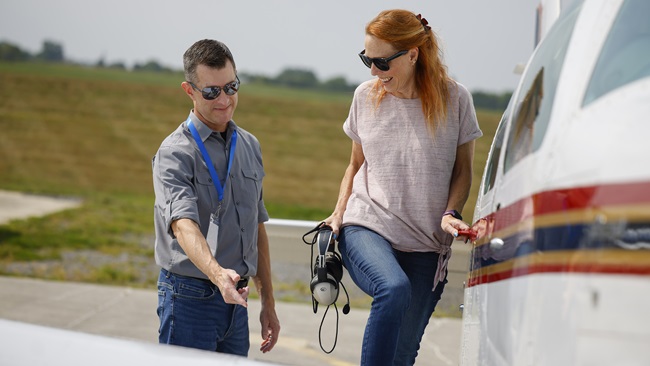Career Pilot: Rejected takeoffs
Breaking down the dreaded abort
Despite being nearly at V1 (takeoff decision speed), the crew did an admirable job of recognizing the failure and initializing rejected takeoff procedures.
To give you an idea of how much damage this type of engine failure can cause, one fragment of the turbine disk—weighing more than 56 pounds—penetrated the engine cowling and right wing, severed the main fuel line, penetrated the fuel tank, and still had the energy to travel more than a half mile through the air, break through a warehouse ceiling, and come to rest on the floor of the building, according to the National Transportation Safety Board’s review of the accident.
Because of the fuel-tank breach, a fire erupted before the airplane came to a stop and continued to burn, eventually totaling the airplane. While the aborted takeoff went well, the evacuation wasn’t without fault, resulting in one serious injury and 19 minor injuries to passengers. The airplane is still parked on the north side of O’Hare if you happen to visit the airport.
High-speed rejected takeoffs are high-risk maneuvers and often result in aircraft damage in the form of hot brakes and blown tires. Needless to say, the decision to abort should not be taken lightly, and it has to be made quickly since a delay of just a few seconds may result in a trip off the end of a runway—or worse. To simplify things for pilots, we break down the takeoff into low-speed and high-speed regimes.
High-speed rejected takeoffs are high-risk maneuvers. The decision to abort should not be taken lightly.At my airline, 100 knots is the dividing line between the regimes where the captain’s decision-making shifts from rejecting takeoff for many items to aborting takeoff for only serious emergencies such as a fire, engine failure, or wind shear. The energy state of an airliner above 100 knots is substantial, and the dangers of high-speed aborts for relatively minor issues become a significant risk.
Modern airliners that use engine instrumentation and crew alerting systems (EICAS) make rejected takeoff decision making easier. If you’re above 100 knots and you see a red EICAS alert, reject the takeoff. If it’s yellow, continue. At our recurrent training sessions, rejected takeoffs are drilled. At 120 knots, a yellow attention-getter goes off alerting you to an overwing exit door being open. Do you abort?
While the thought of passengers sitting next to an open window exit is disturbing, the reality is the airplane will fly just fine with that door open, if it really is open. More likely it’s a false indication. Bird strike on (not through) your windshield at 130 knots? Keep going. Cockpit window opens at 120 knots? Keep going. In other words, in the high-speed regime, rejected takeoffs are only for serious malfunctions or extreme events.
If the decision is made to reject the takeoff, it’s imperative to make sure the speedbrake/ground spoiler systems deploy quickly. Those spoilers are critical to killing lift by the wing and transferring airplane weight back to the wheels. Once the weight is on the wheels, the brakes become very effective. Of course, backing up braking with reverse thrust also helps, especially on wet, snowy, or otherwise contaminated runways.
Once stopped, it’s time to assess the situation. Since you don’t have the full picture in the cockpit, it’s time to make use of resources such as the tower controllers and the flight attendants. Is there smoke or fire? Do we need to evacuate? The decision to evacuate shouldn’t be taken lightly since it nearly always results in at least some injuries. If possible, it’s best to keep the folks on the airplane if conditions permit and return to a gate after the brakes cool off.
In the aborted takeoff of the American 767, the evacuation didn’t go as smoothly as hoped. Flight attendants, upon seeing smoke and fire, initiated an evacuation without making contact with the cockpit. Unfortunately, the left engine was still running as passengers exited that side of the aircraft, resulting in injuries after passengers escaping the left rear exit were blown over by the thrust. But evacuations are a topic for an article of its own. Read more about this incident on the NTSB website.


